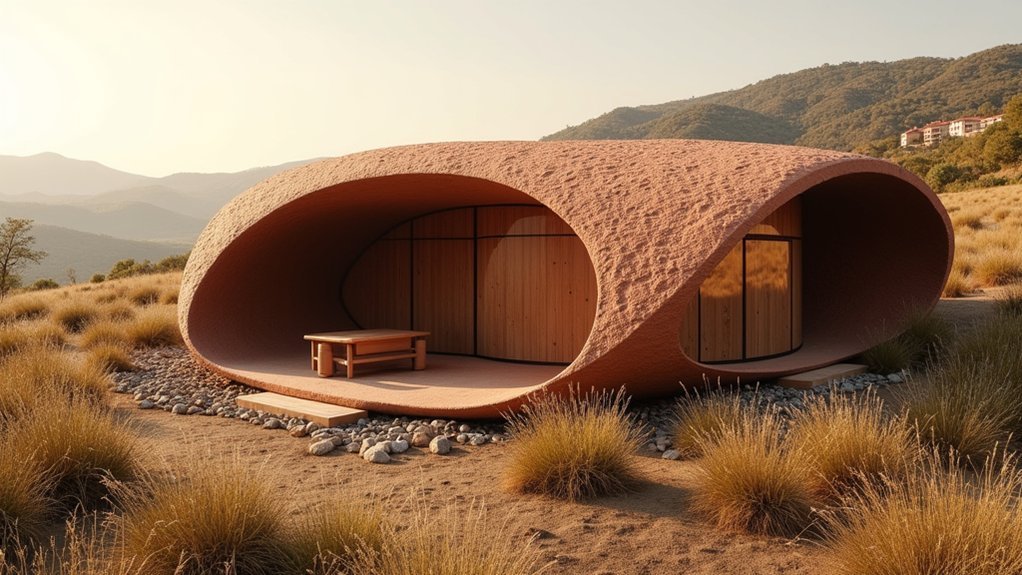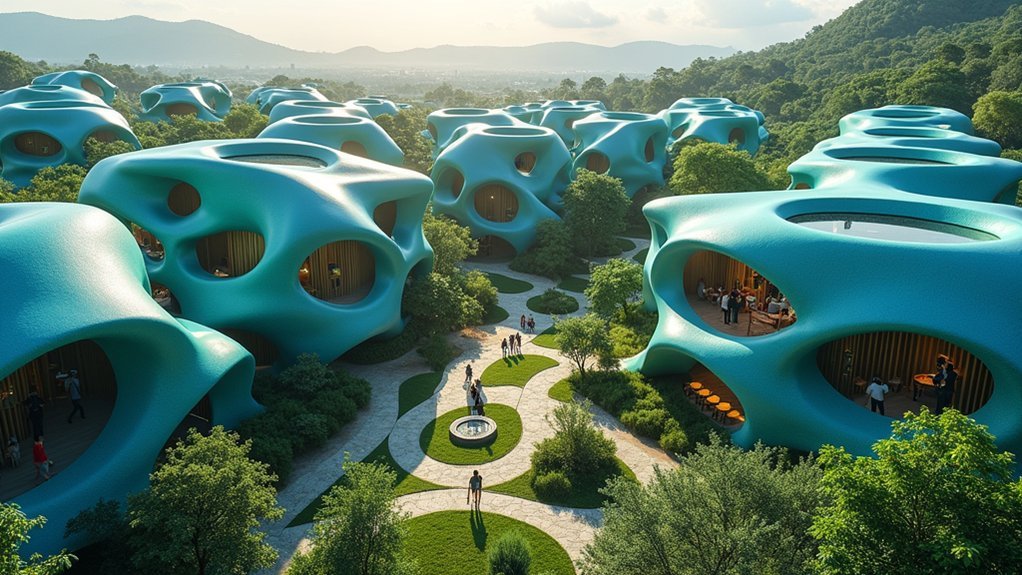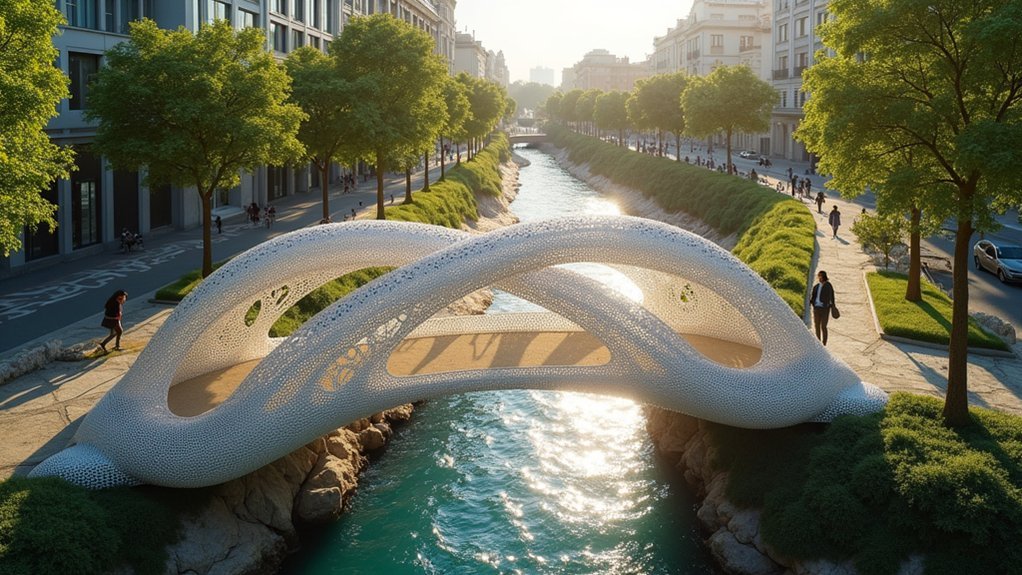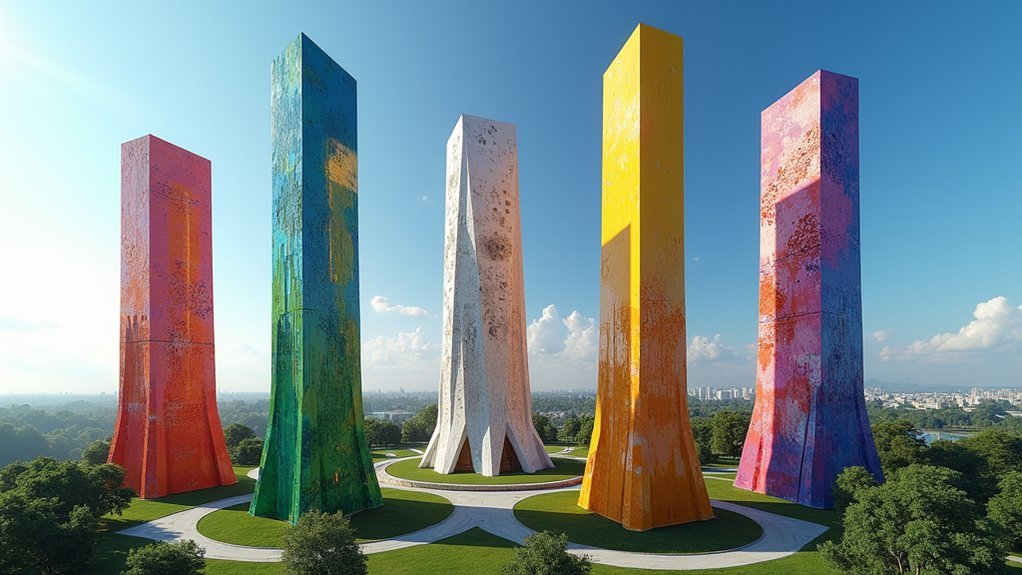You’re witnessing architecture’s most dramatic transformation as 3D printing technology moves from creating small prototypes to constructing entire buildings, bridges, and housing complexes. TECLA in Italy uses locally sourced clay for sustainable dwellings, while Austin’s House Zero achieved structural completion in just 24 hours using robotic concrete printing. France’s YHNOVA demonstrates multi-material social housing innovation, Copenhagen’s BOD Building represents Europe’s first fully 3D-printed structure, and Madrid’s futuristic pedestrian bridge showcases complex geometries that’ll reshape tomorrow’s urban landscapes.
TECLA: Italy’s Groundbreaking Clay-Based 3D Printed Dwelling

One revolutionary prototype in Italy demonstrates how 3D printing technology can transform sustainable housing through locally sourced materials.
TECLA, designed by Mario Cucinella Architects and developed by WASP, showcases how you can create eco-friendly dwellings using natural clay from the surrounding area. This innovative construction process merges traditional building techniques with cutting-edge 3D printing capabilities, allowing you to achieve complex shapes that conventional methods can’t replicate.
You’ll find TECLA’s design prioritizes energy efficiency while demonstrating sustainable practices throughout its creation. The project proves you can utilize rapid construction methods without compromising environmental responsibility.
House Zero: Austin’s Speed Record-Breaking Concrete Construction
While traditional construction methods require weeks or months to complete residential structures, House Zero in Austin, Texas shattered industry expectations by achieving full structural completion in just 24 hours using advanced 3D-printed concrete technology.
You’ll witness how this architectural printing breakthrough demonstrates unprecedented speed and efficiency in residential construction.
The project’s robotic arm precisely deposits specialized concrete layer by layer, following digital design specifications that enable innovative designs impossible with conventional techniques.
You’ll appreciate how this process dramatically reduces material waste while maintaining structural integrity and aesthetic appeal.
House Zero proves that large-scale additive manufacturing can address affordable housing shortages through rapid customization.
You’re seeing the future where construction time becomes measured in hours rather than months, revolutionizing how we approach residential development.
YHNOVA: France’s Multi-Material Social Housing Innovation

Building upon Austin’s speed achievements, YHNOVA in Nantes, France took 3D-printed construction further by introducing multi-material innovation that transforms social housing development.
You’ll find this pioneering project completed in just 54 hours, combining concrete and insulation materials through an innovative construction approach that addresses affordable housing demands.
YHNOVA’s multi-material approach enables complex designs impossible with traditional methods, releasing unprecedented architectural creativity.
You can see how this construction technology creates intricate geometric forms while maintaining structural integrity and energy efficiency through sustainable materials integration.
The collaboration between University of Nantes and local government demonstrates commitment to revolutionary social housing solutions.
You’re witnessing how 3D printing technology reduces waste while promoting environmentally responsible practices, setting new standards for innovative construction that balances affordability, sustainability, and design sophistication.
The BOD Building: Copenhagen’s European 3D Printing Milestone
France’s groundbreaking work with YHNOVA sparked similar innovation across Europe, where Copenhagen’s BOD Building emerged as the continent’s first fully 3D-printed structure.
This milestone project demonstrates how additive manufacturing transforms architecture and construction practices.
COBOD’s BOD2 printer revolutionized the building process by creating innovative curvilinear walls that showcase 3D printing’s design flexibility.
The BOD2 printer’s curvilinear walls demonstrate how 3D printing technology unlocks unprecedented architectural design possibilities in modern construction.
You’ll notice how this technology considerably reduces construction time compared to traditional construction methods while maintaining structural integrity.
The project’s sustainability focus minimizes material waste throughout the entire building process.
Key innovations include:
- Efficient construction timeline that’s considerably faster than conventional methods
- Eco-friendly practices integrated throughout the additive manufacturing process
- Curvilinear wall designs impossible with traditional construction techniques
This pioneering structure establishes Copenhagen as a leader in promoting mainstream 3D printing adoption across Europe’s construction industry.
Madrid’s Pioneering 3D Printed Pedestrian Bridge

As construction innovation spread beyond Copenhagen, Madrid captured international attention with its groundbreaking “Bridge of the Future” – a 12-meter pedestrian bridge that showcases 3D printing’s potential in public infrastructure.
You’ll find this remarkable structure was completed in just 12 hours using specialized printed concrete designed for additive manufacturing. The construction industry witnessed how large-scale printing enables complex geometries while reducing material waste considerably.
This innovative design demonstrates 3D printing’s viability in real-world applications, marking a milestone for functional infrastructure development.
The project’s success influences future architectural designs and construction practices, proving that concrete can be precisely deposited through advanced printing technologies.
You’re seeing how this breakthrough promotes integrating 3D printing into urban development, revolutionizing traditional building methods.
Frequently Asked Questions
What Are the Typical Cost Savings Compared to Traditional Construction Methods?
You’ll typically see cost savings of 15-30% compared to traditional construction. You’re reducing labor costs, material waste, and construction time considerably. However, you’ll need substantial upfront investment in specialized equipment and training.
How Do Building Codes and Regulations Adapt to 3D Printed Structures?
You’ll find building codes slowly updating through pilot programs and temporary permits. Regulators’re creating new standards for 3D printed materials, structural testing requirements, and safety protocols as they evaluate each project case-by-case.
What Happens to Construction Workers as Automation Increases in Building Projects?
You’ll see construction jobs evolve rather than disappear. You’ll need new skills operating 3D printers, maintaining robotic equipment, and performing specialized tasks automation can’t handle like electrical work and finishing.
Can 3D Printed Buildings Withstand Earthquakes and Extreme Weather Conditions Equally Well?
You’ll find 3D printed buildings can match traditional construction’s seismic resistance through proper design and materials, but they’re still being tested for long-term durability against extreme weather conditions.
How Long Do 3D Printed Building Materials Last Compared to Conventional Materials?
You’ll find 3d printed concrete typically lasts 50-100 years, matching traditional concrete’s lifespan. However, you’re dealing with newer technology, so long-term durability data remains limited compared to centuries-proven conventional materials.





Leave a Reply